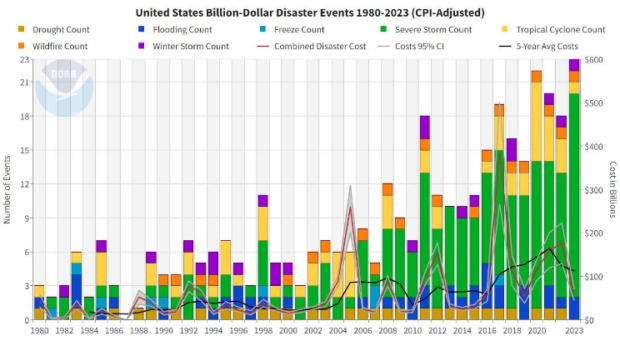Between January 2020 and December 2022, 60 climate-related disasters, costing nearly $1 billion each, caused 1,460 fatalities and 2,939 injuries, according to data from the National Oceanic and Atmospheric Administration.
This marks a significant increase in costly climate-related disasters from decades prior, according to a new report released by the Federal Emergency Management Agency.
Previous decade totals for billion-dollar climate-related disasters (inflation-adjusted) were:
- 33 (1980-1989)
- 57 (1990-1999)
- 67 (2000-2009)
- 131 (2010-2019)
The December 2023 “National Preparedness Report,” based on data as of Dec. 31, 2022, noted that in 2022 alone, NOAA identified that 18 incidents resulted in losses exceeding $1 billion each. These 18 incidents included one drought, one flood, one wildfire, one winter storm, three tropical cyclones and 11 severe storms.
In 2022, the President declared 47 major climate-disasters, 10 emergencies, and 33 Fire Management Assistance Grants (FMAG), resulting in 474 deaths and a total cost of $165 billion—the third costliest year on record behind 2005 and 2017, the agency noted.
For perspective, in 2016 during the peak of hurricane season, FEMA was managing 30 major disasters in 18 joint field offices (JFO).
At the same point in 2023, FEMA was managing over twice the number of major disasters (i.e., 71) in 25 JFOs.
Currently, the agency is in its sixth year of operating with higher average daily deployments, which have doubled from 3,331 responders pre-2017, to 7,113 responders post-2017.
Despite the increase in frequency and severity in hazards, preparedness is low.
FEMA’s 2022 National Household Survey on Disaster Preparedness found that 42 percent of respondents plan to prepare for identified threats and hazards in the future.
The percentage of survey participants indicating they did not intend to prepare decreased from 17 percent in 2017 to 9 percent in 2020 but rebounded to 14 percent in 2022, FEMA analysis showed.
The five threats and hazards communities reported as most likely to occur between 2019 to 2022, included cyber attacks, pandemics, floods, active shooter incidents and earthquakes.
The FEMA report noted regional differences in the types of disasters that communities report as most challenging. For example, communities across the West most frequently reported wildfires, cyber attacks and earthquakes as their top threats and hazards of concern, while communities in the Northeast and South most frequently reported cyber attacks, pandemics and hurricanes/typhoons. Midwestern communities most frequently reported cyber attacks, tornadoes and pandemics as their top threats and hazards of concern, the FEMA report stated.
High-risk census tracts are heavily concentrated in the Western United States due to high population density along coastlines and high expected annual economic losses (in dollars) due to natural hazards.
The South, Midwest, and the states of Florida and Hawaii face similar high-risk levels, the report found, adding that the high-risk rankings are attributable to natural hazards such as hurricanes/typhoons, tornadoes and severe weather (strong winds, heat waves and winter weather), along with the high population density along coastlines.
Inconsistent adoption of building codes is one of the most significant factors compounding risk and increasing costs resulting from natural disasters.
The inconsistent adoption of building codes is one of the most significant factors compounding risk and increasing costs resulting from natural disasters, the agency said. Two out of three communities in the United States still need to incorporate the latest building codes.
Because the federal government has no authority to enforce building codes, the responsibility rests with local and state governments.
“This decentralization results in a wide variation in the adoption of model building codes and retention of hazard-resistant provisions in these model codes, code enforcement and administration mechanisms, and funding for enforcement, administration, outreach and support,” the report stated.





















 Aon Adds to List of Brokers Suing Howden US for Alleged Poaching, Theft
Aon Adds to List of Brokers Suing Howden US for Alleged Poaching, Theft  AI in Property/Casualty Insurance: Why Trusted Data Is the Missing Link
AI in Property/Casualty Insurance: Why Trusted Data Is the Missing Link  Rebuilding Negotiation Talent: Why This Skill Is Missing and How to Fix It
Rebuilding Negotiation Talent: Why This Skill Is Missing and How to Fix It  Artificial Intelligence Is Rewriting the Rules for Commercial Lines
Artificial Intelligence Is Rewriting the Rules for Commercial Lines 